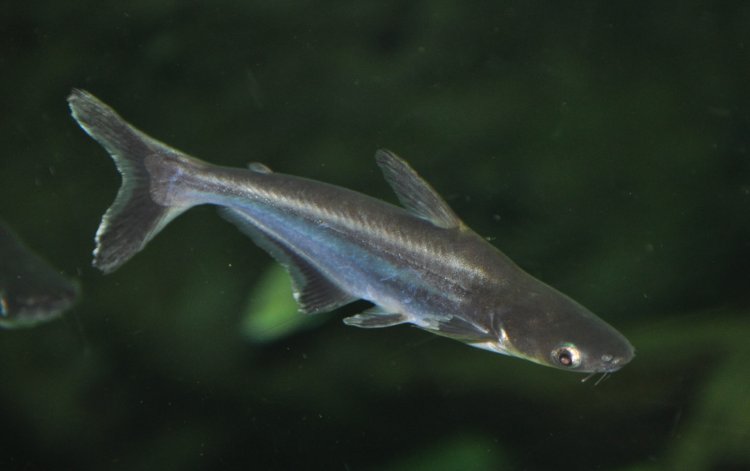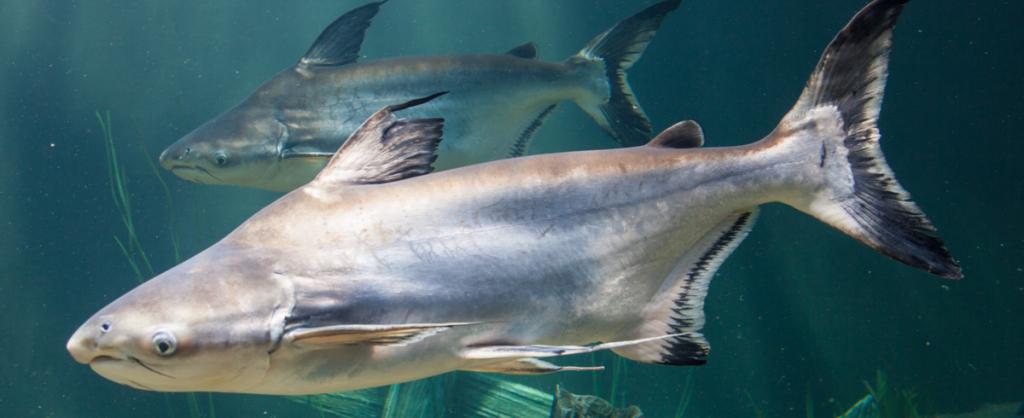The aquarium pangasius attracts many aquarists with its unusual appearance. In stores, their fry are sold as ornamental fish, while often silent about the problems that a new owner may encounter. In particular, it is often silent about the sizes that this fish reaches regardless of the volumes in which it lives.
General information
Aquarium pangasius with its appearance is very similar to a shark. Therefore, its second name is “shark catfish”. “Freshwater shark” and “Siamese catfish” are two more common names for this fish. The average life span of fish is 20 years. At the same time, the pangasius has very large sizes. In nature, it can reach up to 130 cm long, and the average weight of an adult fish is 44 kg. In captivity, it rarely grows more than 50-70 cm, but even with such dimensions it is a very large aquarium fish that needs large volumes. Aquarium pangasius - schooling fish. Feels best in a group of 5 individuals. Given the size of each fish and the love of shark catfish to frolic and swim, the flock needs a huge aquarium, which amateur aquarists can rarely afford.

Another snag is that aquarists are often seduced by the appearance of juvenile pangasius. These are dark fish, cast in silver and very similar in appearance to sharks. But with age, their coloring changes. Adult individuals become monotonous gray, while quite large. In addition, over time, their activity decreases, and they become less interesting for observation. Therefore, you should think carefully before you get this fish as a pet. With its own unpretentiousness and interesting appearance, the aquarium pangasius is a fish difficult to maintain, because it is difficult to configure optimal conditions for keeping it.
Appearance and sexual dimorphism
The juvenile pangasius aquarium catfish has a rather dark color. Along the sideline are long dark stripes. The skin reflects light and shimmers beautifully. Adult individuals have a plain gray color. The head is small, large eyes are set on it. The body is thickened, devoid of scales. Unlike other types of catfish, there are no bone plates on the skin of the aquarium pangasius, so the fish are often injured. On the jaws you can see small sharp teeth. There are two pairs of antennae on the muzzle: the lower ones are longer than the upper ones. The fins are black or dark gray. The dorsal fin consists of 6 branched rays. There are one or two spikes on it. There are thorns on the pectoral fins. The caudal fin is two-bladed. Below are photos of the aquarium pangasius.

Sexual dimorphism is manifested only in adults, therefore, when buying juveniles, it is difficult to determine the sex of the fish. Females are larger than males and look much more powerful. In adulthood, they have a lighter body color.
Behavior
Aquarium pangasius is very shy. This is especially true for juveniles. Any noise, sudden movement, flash of light, can cause a panic attack in the flock. The fish will start to rush about the aquarium and beat about everything around. With a sharp change in the conditions of detention or the sharing of a new neighbor, the fish are able to fall into a stupor. They freeze in place and do not move. Frightened, they can pretend to be dead. In a state of stupor, they stay no more than half an hour. When the fish realizes that it is not in danger, it will begin to explore the surrounding space with interest.
Shark catfish is very active, and therefore interesting for observation. He needs a lot of space for swimming. Usually the fish scurry around the aquarium in flocks, and with a sense of danger they immediately try to hide.
Habitat
The fish received its first description in 1878. In nature, it lives in river basins located in Vietnam, Laos, and Thailand. It was from there that fish got its distribution throughout Southeast Asia. There it is used on an industrial scale. In Asia, shark catfish is eaten.
Young fish are found in huge schools. Adult fish live in small groups. They feed in nature on insect larvae, invertebrates, shrimps, vegetables and fruits.
Aquarium Maintenance
Since this is a large schools of flocks, a large tank size is required to maintain an aquarium pangasius. An aquarium of 400 liters is suitable for a flock of young animals. Over time, you will need an aquarium with a minimum volume of 1200 liters.
The fish is unpretentious regarding the conditions of detention. The optimum water temperature is 22-26 degrees. Fish have rather defenseless and sensitive skin. If damaged, fungus may form on it. That is why a clean aquarium is very important for pangasius. Water changes should be done weekly by at least 30 percent of the total. In the aquarium there should be a powerful filter that will create a flow. Aeration required. The equipment inside the aquarium should be hidden with the help of decorations, because shy fish can break it in a fit of panic.
Inside the aquarium you need to put shelters in which nervous juveniles can hide. At the bottom, you can put sand or edged gravel. Aquarium pangasius loves to dig soil, therefore plants need to be planted in it with a well-developed root system. Need a lot of free space for swimming. From fright, the pangasius can jump out of the aquarium as well, so it should be covered with a lid. In bright light, the fish can be very nervous, because it is undesirable.
Feeding
Aquarium pangasius is quite voracious, so you need to take care not to overfeed the fish. One day a week, you can don’t feed the fish at all, to prevent obesity.
Shark catfish can be fed dry, frozen and live food. It is necessary to give plant nutrition. For feeding, you can use the tubifex, bloodworms, small invertebrates. You need to feed in small portions 2-3 times a day. Food should be given as much as the fish can eat within 5 minutes. In addition, aquarium pangasius eat only the food that is in the middle layers of water. Fish may refuse to eat due to overly bright lighting. In this case, she feels defenseless, and therefore nervous. During feeding, it is worth dimming the lighting. With age, fish lose their teeth and begin to eat only plant foods. For feeding, you can use lettuce, thin slices of zucchini, grated cucumbers.
Compatibility
Aquarium pangasius - schooling fish. For a comfortable existence, it is best to acquire a group consisting of at least five individuals. This is a very shy fish, which from any sharp noise starts to rush in a panic. At the same time, it can harm not only yourself, but also other neighbors in the aquarium. Therefore, do not scare the fish once again to avoid unnecessary injuries.
This is a fairly friendly fish, but you should not settle fish for it, which shark catfish can swallow. Larger fish can irritate the pangasius, cause panic attacks, which will injure the fish. Shark catfish are better to settle with commensurate peace-loving fish: cichlids, labeos, large barbs. With timely and high-quality feeding, you can add gourami and iris to the aquarium. Aquarium pangasius live in the middle layers of water, therefore, fish that live in the lower layers are worth living with them. They will pick up fodder that has fallen to the bottom, thereby cleaning the soil from food debris.
Breeding
Young pangasius aquarium fish are imported from their homeland. And all because it is almost impossible to achieve the reproduction of fish at home. It is too difficult to recreate the conditions necessary for spawning. It is easier to put fish from places where it is bred on an industrial scale. Fish are bred in huge artificial reservoirs, or fry are caught in nature, and then grown.
Males are ready for breeding from two years, and males from three. Spawning lasts from the beginning of summer until late autumn. Fish rush upstream to spawning grounds. Females lay eggs in dense algae. At one time, one female is capable of sweeping more than one million eggs. Fry is born after a couple of days.
Possible diseases
Aquarium fish pangasius needs a good filtration of water. Due to severe pollution, it can lose activity and become ill. An aquarium pangasius is often injured when it rushes about in an aquarium in a fright.
One of the most common bacterial infections of shark catfish is bacillary necrosis of pangasius. Its main symptoms are hemorrhage in the eyes and fins; cell necrosis; spots on the liver, kidneys and spleen. Antibiotics are used for its treatment.
Pangasius can suffer from jaundice, the main symptom of which is the yellow color of the meat. To cure the fish, they give antibiotics along with food, and in this case they try to improve the quality of the water.
Bacterial hemorrhagic septicemia is an infectious disease. Its main symptoms: abdominal distention, bleeding in the eyes, fins and body. Antibiotics and improving conditions help to cope with it.
Thus, the aquarium shark Pangasius is a beautiful and very large fish. It is unpretentious, but for its maintenance at home, you need a very large aquarium. The fish are peaceful, but they should be settled with commensurate species of fish. Since the shark catfish is very shy, there should not be any sharp decorations in the aquarium that it could hurt. Under the right conditions and good varied feeding, fish can live up to 20 years.